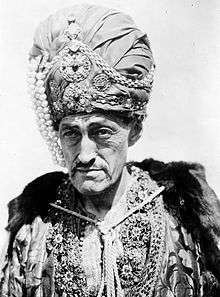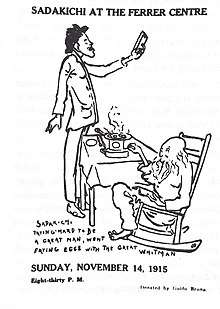Sadakichi Hartmann
Carl Sadakichi Hartmann (November 8, 1867 – November 22, 1944) was an American art and photography critic, notable anarchist and poet of German and Japanese descent.

Biography
Hartmann, born on the artificial island of Dejima, Nagasaki to a Japanese mother Osada Hartmann (who died soon after childbirth) and German businessman Carl Herman Oskar Hartmann and raised in Germany, arrived in Philadelphia in 1882 and became an American citizen in 1894.[1] An important early participant in modernism, Hartmann was a friend of such diverse figures as Walt Whitman, Stéphane Mallarmé and Ezra Pound.
Around 1905, Hartmann was an occasional performer at the New York City Miner's Theater. His act involved a device which dispensed perfumes in a manner intended to be analogous to notes in a symphony, which was poorly received by the crowd.[2]
His poetry, deeply influenced by the Symbolists as well as orientalist literature, includes 1904's Drifting Flowers of the Sea and Other Poems, 1913's My Rubaiyat and 1915's Japanese Rhythms. His works of criticism include Shakespeare in Art (1901) and Japanese Art (1904). During the 1910s, Hartmann let himself be crowned King of the Bohemians by Guido Bruno in New York's Greenwich Village.[3] Hartmann wrote some of the earliest English language haiku.
He was one of the first critics to write about photography, with regular essays in Alfred Stieglitz's Camera Notes. Hartmann published criticism and conducted lecture tours under the pseudonym "Sidney Allen."[4]
He made a brief appearance in the Douglas Fairbanks film The Thief of Bagdad as the court magician.[3]
Later years found him living in Hollywood and, by 1942, on his daughter's ranch outside Banning, California. Due to his age and health conditions, Hartmann was one of only a few Japanese Americans on the West Coast to avoid the mass incarceration during World War II, although the FBI and local officials visited the ranch often to conduct investigations.[1] In 1944, he died while visiting another daughter in St. Petersburg, Florida. A collection of his papers is held at the University of California, Riverside, including correspondence related to his obtaining permission to remain in Banning during the war.
Please note this is about the text of this Wikipedia article; it should not be taken to reflect on the subject of this article.
Do not restore or edit the blanked content on this page until the issue is resolved by an administrator, copyright clerk or OTRS agent.
If you have just labeled this page as a potential copyright issue, please follow the instructions for filing at the bottom of the box.

The previous content of this page or section has been identified as posing a potential copyright issue, as a copy or modification of the text from the source(s) below, and is now listed on Wikipedia:Copyright problems :
Unless the copyright status of the text on this page is clarified, the problematic text or the entire page may be deleted one week after the time of its listing (i.e. after 20:28, 2 August 2020 (UTC)).
Temporarily, the original posting is still accessible for viewing in the page history.
- You must permit the use of your material under the terms of the Creative Commons Attribution-Sharealike 3.0 Unported License (CC-BY-SA) and the GNU Free Documentation License (GFDL) (unversioned, with no invariant sections, front-cover texts, or back-cover texts).
- Explain your intent to license the content on this article's discussion page
- To confirm your permission, you can either display a notice to this effect at the site of original publication or send an e-mail from an address associated with the original publication to permissions-en

- Note that articles on Wikipedia must be written from a neutral point of view and must be verifiable in published third-party sources; consider whether, copyright issues aside, your text is appropriate for inclusion in Wikipedia.
Your rewrite should be placed on this page, where it will be available for an administrator or clerk to review it at the end of the listing period. Follow this link to create the temporary subpage.
- Simply modifying copyrighted text is not sufficient to avoid copyright infringement—if the original copyright violation cannot be cleanly removed or the article reverted to a prior version, it is best to write the article from scratch. (See Wikipedia:Close paraphrasing.)
- For license compliance, any content used from the original article must be properly attributed; if you use content from the original, please leave a note at the top of your rewrite saying as much. You may duplicate non-infringing text that you had contributed yourself.
- It is always a good idea, if rewriting, to identify the point where the copyrighted content was imported to Wikipedia and to check to make sure that the contributor did not add content imported from other sources. When closing investigations, clerks and administrators may find other copyright problems than the one identified. If this material is in the proposed rewrite and cannot be easily removed, the rewrite may not be usable.
- Posting copyrighted material without the express permission of the copyright holder is unlawful and against Wikipedia policy.
- If you have express permission, this must be verified either by explicit release at the source or by e-mail or letter to the Wikimedia Foundation. See Wikipedia:Declaration of consent for all enquiries.
- Policy requires that we block those who repeatedly post copyrighted material without express permission.
If you have tagged the article for investigation, please complete the following steps:
- Add the following to the bottom of Wikipedia:Copyright_problems/2020 July 26
* {{subst:article-cv|Sadakichi Hartmann}} from https://books.google.com/books?id=X6X_AwAAQBAJ&pg=PA124. ~~~~ - Place this notice on the talk page of the contributor of the copyrighted material:
{{subst:Nothanks-web|pg=Sadakichi Hartmann|url=https://books.google.com/books?id=X6X_AwAAQBAJ&pg=PA124}} ~~~~ - To blank a section instead of an entire article, add the template to the beginning of the section and {{Copyvio/bottom}} at the end of the portion you intend to blank.
Bibliography
- Christ: A Dramatic Poem in Three Acts (play, 1893)
- Buddha: A Drama in Twelve Scenes (play, 1897)
- Mohammed (play, 1899)
- Schopenhauer in the Air: Seven Stories (1899)
- Shakespeare in Art (1900)
- A History of American Art (1901)
- Japanese Art (1903)
- Drifting Flowers of the Sea and Other Poems (1904)
- Landscape and Figure Composition (1910)
- My Theory of Soul Atoms (1910)
- The Whistler Book (1910)
- My Rubaiyat (1913)
- Permanent Peace: Is it a Dream? (1915)
- Tanka and Haikai: Japanese Rhythms (1916)
- The Last Thirty Days of Christ (1920)
- Confucius: A Drama in Two Acts (play, 1923)
- Moses: A Drama in Six Episodes (play, 1934)
- Buddha, Confucius, Christ: Three Prophetic Plays (reprint collection, 1971)
References
- Niiya, Brian. "Sadakichi Hartmann". Densho. Retrieved 12 August 2014.
- Sante, Luc (2003). Low life: lures and snares of old New York (1st Farrar, Straus Giroux pbk. ed.). New York: Farrar, Straus Giroux. pp. 93–94. ISBN 0374528993. OCLC 53464289.
- William Bryk (26 January 2005). "King of the Bohemians". The New York Sun.
- Weaver, Jane Calhoun (ed.) (1991). Sadakichi Hartmann: Critical modernist: Collected Art Writings. Berkeley: University of California Press. p. 10. ISBN 0520067673.CS1 maint: extra text: authors list (link)
- Avrich, Paul (2006). The Modern School Movement. Oakland CA: AK Press. pp. 134–138. ISBN 1-904859097.
Further reading
- Bell, Bill (Fall 2018). "In Search of Sadakichi Hartmann". The Riverside County Chronicles. Riverside County Heritage Association (19): 10–28. ISBN 978-1729660737.
- Minutes of the Last Meeting Gene Fowler, Viking Press, 1954 (Reminiscences of Hartmann from his final days in Hollywood)
- The Modern School Movement Paul Avrich, AK Press, 2006 (First published in 1980 by Princeton University Press)
External links
| Wikimedia Commons has media related to Sadakichi Hartmann. |
- Detailed Biography, Bibliography and More at Modern American Poetry
- Guide to the Sadakichi Hartmann papers University of California, Riverside
- Works by or about Sadakichi Hartmann at Internet Archive
- Works by Sadakichi Hartmann at LibriVox (public domain audiobooks)

- Sadakichi Hartmann Correspondence and Manuscripts Dartmouth College Library
